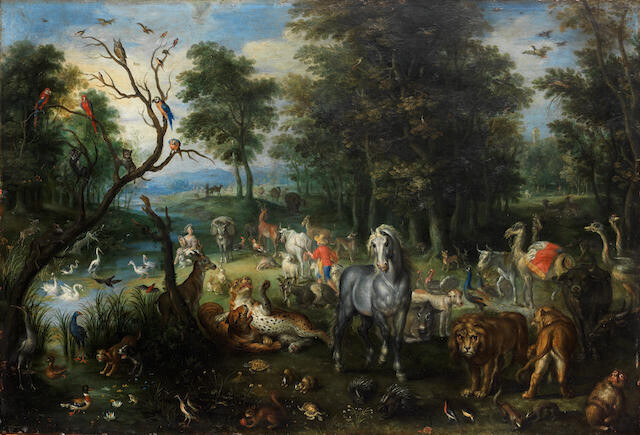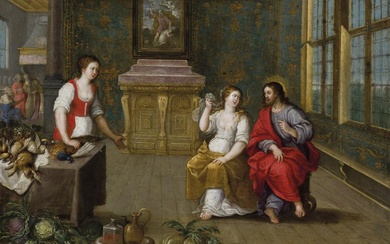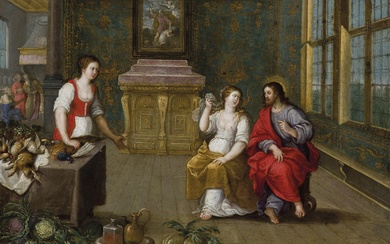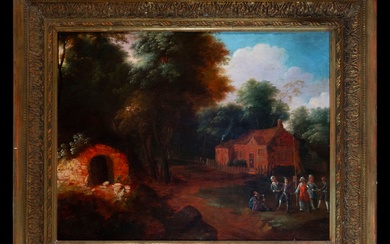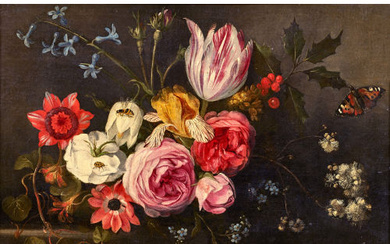Jan Brueghel the Younger, (Antwerp 1601-1678)
The Four Elements: An Allegory of Earth; An Allegory of Water; An Allegory of Air; and An Allegory of Fire 33.6 x 50cm (13 1/4 x 19 11/16in).; 32.9 x 48cm (12 15/16 x 18 7/8in).; 32.9 x 48cm (12 15/16 x 18 7/8in).; and 32.9 x 48.1cm (12 15/16 x 18 15/16in). (4)
The Four Elements: An Allegory of Earth; An Allegory of Water; An Allegory of Air; and An Allegory of Fire
a set of four, oil on copper
33.6 x 50cm (13 1/4 x 19 11/16in).; 32.9 x 48cm (12 15/16 x 18 7/8in).; 32.9 x 48cm (12 15/16 x 18 7/8in).; and 32.9 x 48.1cm (12 15/16 x 18 15/16in). (4)
Provenance
Acquired by the current owner's father approximately 60 years ago in Spain
This set of allegories is remarkable, not only for all four subjects having survived together in an outstanding state of preservation, but is exceptional within the artist's oeuvre for the landscapes, the animals, the flowers and the figures (including the larger, principal figures) having been entirely painted by Jan Brueghel the Younger without collaboration with other artists. The copper supports which allow both refined and delicate detail and for a luminosity of surface enabled the artist to exhibit his skills at their utmost.
Allegories of the Four Elements were of particular appeal to artists of the 16th and 17th centuries who could take advantage of the endless possibilities for imaginative symbolism while allowing them to display extraordinary technical mastery in depicting the flora and fauna of the natural world. Earlier examples included Giorgio Vasari's frescoes in the Sala degli Elementi in the Palazzo Vecchio in Florence executed between 1555 and 1557; Giuseppe Arcimboldo's fantastical heads which he painted for the Emperor Maximilian II in 1566; while among Cardinal Federico Borromeo's commissions from Jan Brueghel the Elder were allegories of the Four Elements, executed like the present group on a small scale on copper. For the future Archbishop of Milan 'Paintings capture heaven and earth in the smallest of spaces, and we wander around inside them, undertaking long spiritual journeys, while standing still in our room.'
The palette of the present set of Four Elements is characteristic of Jan Brueghel the Younger's early output and can be dated to his return from Italy to Antwerp at the end of the 1620s. While the inspiration behind all four of these compositions was his father, Jan Brueghel the Elder (in collaboration with the figure painter, Hendrick van Balen), the younger Jan Brueghel was here able to connect old ideas with new ones, creating something original. Thus, the present set of copper panels is also exceptional in that for his Allegory of Earth, rather than employing the usual device of Ceres, the goddess of agriculture and fertility, he chose a Paradise landscape, which would otherwise have either represented the Old Testament theme of the Entry of the animals into Noah's Ark or the Garden of Eden. The former is suggested by the procession of creatures making their way, largely two by two towards a tiny ark visible in the background. With its symbolism of Original Sin, the latter subject had been popular amongst artists from the days of Albrecht Dürer and Lucas Cranach the Elder in the sixteenth century, but in this instance it appears to have interested Brueghel more for allowing him to display his fascination with the exotic beauty of the natural world. Precedents for animal paintings were found in fable illustrations, emblem books, bestiaries, hunting texts and tapestries. But the 'animal parks' that proved popular for seventeenth century artists, such as the Jan Brueghels, Roelandt Savery and Aelbert Cuyp, even when presented under the guise of traditional subjects, such as The Fall, Noah's Ark and Orpheus among the Beasts, displayed a whole new genre for easel painting. This genre may be placed in the context of the beginnings of the Scientific Revolution, which saw man's desire to record and categorise nature and coincided with the keeping of princely menageries, the first extensive collections of rare and unusual plants and the cult of the kunstkammer, a repository of such naturalia as antlers, shells, fossils and skeletons.
A member of a large and successful family of artists, Jan Brueghel the Younger very probably began his training at the age of ten in the studio of his father, Jan Brueghel the Elder, whose works had a heavy influence on the younger painter. After travelling to Milan to meet Jan Brueghel the Elder's patron, Cardinal Federico Borromeo, in the spring of 1624, Jan the Younger decided to prolong his Italian journey and went to Palermo with his childhood friend, Anthony van Dyck. However, this expedition was cut short: his father and three of his siblings were struck down suddenly by cholera in 1625 and Jan returned to Antwerp where he took over his father's studio. Once back in Antwerp, Jan the Younger sold the remaining paintings by his father and completed those not yet finished. His work continued in much the same vein. Like his father, he collaborated frequently with Rubens and Hendrick van Balen, as well as working on occasion with other artists, such as Abraham Janssen (his father-in-law), David Teniers the Younger (his brother-in-law) and Hendrick de Clerck. The importance he attained in the artistic community in Antwerp is reflected in his being head of the Guild of Saint Luke, 1630-31. That importance continued into the 18th century since it is Jan Brueghel the Younger in particular who can be seen as the true father of an inherited family tradition that remains to be treasured by collectors even today.
We are grateful to Dr. Klaus Ertz for confirming the attribution and for dating the present paintings to the late 1620s, after inspection of the originals. A certificate by Dr. Ertz, dated 1 April 2019, is available with this lot, in which he declares that 'the state of preservation of these paintings is very good' and concludes that the landscapes, the animals, the flowers and the figures are by Jan Brueghel the Younger.
View it on
Estimate
Time, Location
Auction House
The Four Elements: An Allegory of Earth; An Allegory of Water; An Allegory of Air; and An Allegory of Fire 33.6 x 50cm (13 1/4 x 19 11/16in).; 32.9 x 48cm (12 15/16 x 18 7/8in).; 32.9 x 48cm (12 15/16 x 18 7/8in).; and 32.9 x 48.1cm (12 15/16 x 18 15/16in). (4)
The Four Elements: An Allegory of Earth; An Allegory of Water; An Allegory of Air; and An Allegory of Fire
a set of four, oil on copper
33.6 x 50cm (13 1/4 x 19 11/16in).; 32.9 x 48cm (12 15/16 x 18 7/8in).; 32.9 x 48cm (12 15/16 x 18 7/8in).; and 32.9 x 48.1cm (12 15/16 x 18 15/16in). (4)
Provenance
Acquired by the current owner's father approximately 60 years ago in Spain
This set of allegories is remarkable, not only for all four subjects having survived together in an outstanding state of preservation, but is exceptional within the artist's oeuvre for the landscapes, the animals, the flowers and the figures (including the larger, principal figures) having been entirely painted by Jan Brueghel the Younger without collaboration with other artists. The copper supports which allow both refined and delicate detail and for a luminosity of surface enabled the artist to exhibit his skills at their utmost.
Allegories of the Four Elements were of particular appeal to artists of the 16th and 17th centuries who could take advantage of the endless possibilities for imaginative symbolism while allowing them to display extraordinary technical mastery in depicting the flora and fauna of the natural world. Earlier examples included Giorgio Vasari's frescoes in the Sala degli Elementi in the Palazzo Vecchio in Florence executed between 1555 and 1557; Giuseppe Arcimboldo's fantastical heads which he painted for the Emperor Maximilian II in 1566; while among Cardinal Federico Borromeo's commissions from Jan Brueghel the Elder were allegories of the Four Elements, executed like the present group on a small scale on copper. For the future Archbishop of Milan 'Paintings capture heaven and earth in the smallest of spaces, and we wander around inside them, undertaking long spiritual journeys, while standing still in our room.'
The palette of the present set of Four Elements is characteristic of Jan Brueghel the Younger's early output and can be dated to his return from Italy to Antwerp at the end of the 1620s. While the inspiration behind all four of these compositions was his father, Jan Brueghel the Elder (in collaboration with the figure painter, Hendrick van Balen), the younger Jan Brueghel was here able to connect old ideas with new ones, creating something original. Thus, the present set of copper panels is also exceptional in that for his Allegory of Earth, rather than employing the usual device of Ceres, the goddess of agriculture and fertility, he chose a Paradise landscape, which would otherwise have either represented the Old Testament theme of the Entry of the animals into Noah's Ark or the Garden of Eden. The former is suggested by the procession of creatures making their way, largely two by two towards a tiny ark visible in the background. With its symbolism of Original Sin, the latter subject had been popular amongst artists from the days of Albrecht Dürer and Lucas Cranach the Elder in the sixteenth century, but in this instance it appears to have interested Brueghel more for allowing him to display his fascination with the exotic beauty of the natural world. Precedents for animal paintings were found in fable illustrations, emblem books, bestiaries, hunting texts and tapestries. But the 'animal parks' that proved popular for seventeenth century artists, such as the Jan Brueghels, Roelandt Savery and Aelbert Cuyp, even when presented under the guise of traditional subjects, such as The Fall, Noah's Ark and Orpheus among the Beasts, displayed a whole new genre for easel painting. This genre may be placed in the context of the beginnings of the Scientific Revolution, which saw man's desire to record and categorise nature and coincided with the keeping of princely menageries, the first extensive collections of rare and unusual plants and the cult of the kunstkammer, a repository of such naturalia as antlers, shells, fossils and skeletons.
A member of a large and successful family of artists, Jan Brueghel the Younger very probably began his training at the age of ten in the studio of his father, Jan Brueghel the Elder, whose works had a heavy influence on the younger painter. After travelling to Milan to meet Jan Brueghel the Elder's patron, Cardinal Federico Borromeo, in the spring of 1624, Jan the Younger decided to prolong his Italian journey and went to Palermo with his childhood friend, Anthony van Dyck. However, this expedition was cut short: his father and three of his siblings were struck down suddenly by cholera in 1625 and Jan returned to Antwerp where he took over his father's studio. Once back in Antwerp, Jan the Younger sold the remaining paintings by his father and completed those not yet finished. His work continued in much the same vein. Like his father, he collaborated frequently with Rubens and Hendrick van Balen, as well as working on occasion with other artists, such as Abraham Janssen (his father-in-law), David Teniers the Younger (his brother-in-law) and Hendrick de Clerck. The importance he attained in the artistic community in Antwerp is reflected in his being head of the Guild of Saint Luke, 1630-31. That importance continued into the 18th century since it is Jan Brueghel the Younger in particular who can be seen as the true father of an inherited family tradition that remains to be treasured by collectors even today.
We are grateful to Dr. Klaus Ertz for confirming the attribution and for dating the present paintings to the late 1620s, after inspection of the originals. A certificate by Dr. Ertz, dated 1 April 2019, is available with this lot, in which he declares that 'the state of preservation of these paintings is very good' and concludes that the landscapes, the animals, the flowers and the figures are by Jan Brueghel the Younger.
